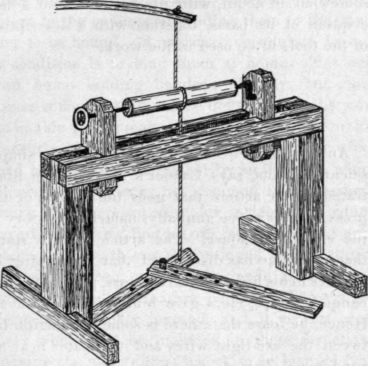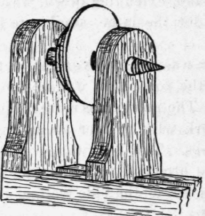History Of The Lathe
In its simplest form - a form which is still employed by the natives of India - the lathe consists of two upright posts, each carrying a fixed pin or dead centre, between which the stock to be turned is made to revolve by an assistant, who pulls alternately the two ends of a cord passed around it. A cutting tool is held firmly in a bar which forms a "rest"; this attacks in succession the projecting parts, and in this way the entire surface is brought to an equal distance from the central axis. In other words, the cross section becomes somewhat circular.
In its rudest form this sort of a lathe consists only of two stakes driven into the ground, through which sharpened nails are driven to support the work. The stock is revolved, as in the first case, by means of a cord in the hands of an assistant.
The first illustration of anything in the shape of a turning lathe was published in a German work in 1568, the picture showing a man at work turning a sphere. The lathe shown is of the most primitive kind, yet the picture shows a number of turned articles, such as tops, vases, balusters, spin-dles, etc., giving evidence of the practical results obtained by its use.
The turner stands with his back against a rail, a custom that is practiced to this day in some parts of Austria and Hungary, where the finest of children's toys are made, equal in many respects to the famous wooden ware of Tunbridge Wells. The manner by which this lathe is driven is not very clear, but from all indications it is probably driven by a pole, as there appears to be one with one of its ends inserted in the wall at the back of the lathe. The stock to be turned was rotated by means of a cord, which was wound around the work two or three times, having one end attached to an elastic pole, and the other formed like a stirrup, into which the foot of the workman was inserted.
When the foot was forced downwards the work would be rotated in the direction of the cutting tool, and the end of the pole bent downwards toward the work. When the foot reached the floor the work would cease to revolve, and the turner was compelled to draw the cutting tool back while the foot was raised, the spring in the pole drawing the stirrup up, thus causing the work in the lathe to rotate in the opposite direction.
When the pole recovered its straight form the operation would be repeated and continued until the job was completed. By this method the stock in the lathe rotated alternately, first in one direction and then in the other, and the operator was compelled to withdraw the cutting tool at every change of motion, - something that must have severely taxed his patience and skill.

Fig. 1,
Fig. 1 shows a "dead-centre lathe" of the kind used in Europe during the eighteenth century, in which the centres are carried by " poppets," which can be adjusted to suit the length of the work, the turner giving the rotation by means of a treadle and spring lath attached to the ceiling. This lath, having immortalized itself by giving its name to the " lathe," has now almost entirely disappeared, the waste of time in its upward stroke (during which time the work revolves in the wrong direction) being a fatal objection to its use in an age in which economy in that respect is of such importance. Dead centre lathes themselves are now almost things of the past, though within their own limits, - which are of course confined to such articles as are turned on the outside only, and can be supported at the ends, - they offer a steadiness of support and a freedom of rotation which others seldom equal and never surpass. The system, however, still survives in the small lathes, or "throws," used by watch and clock makers; and for their purposes it is not likely to be superseded.
Another method of operating the early lathe was by the aid of a bow. This instrument generally had several strings to it, which were fastened to a sort of roller or pulley at their middle point. This roller had a cord attached to it which was wound several times around the material to be turned and, extending down, was fastened to a treadle under the lathe, similar to that shown in Fig. 1.
The bow was an improvement on the pole, as it equalized the force and was not so hard on the operator. The power was more uniform, enabling him to work with greater accuracy on the most delicate jobs. The bow was so constructed that it could be attached to the frame of the lathe, to the ceiling, or to the side wall, as might be most convenient.
Travellers tell us that this kind of lathe is still in use in many parts of India and China, where the itinerant mechanics carry with them their tools, including one of these lathes, and do a job of turning wherever their services may be required. It is stated that their skill in turning with the aid of this rude machine is something marvelous.
It seems to have taken a long time to develop this "treadle-lathe" into the "foot-lathe," the application to it of a fly-wheel worked by a crank and treadle having been exceptional rather than usual even in the early part of the last century, though a separate fly-wheel turned by an assistant had long previously been employed, and must have made possible the turning of heavy work which could not have been attempted without it.
The early attempts at modifying the dead-centre lathes so that articles, such as bowls, vases, and the like, could be turned without the support of what was then called the "back-centre," (corresponding to what we now call the tail-centre or dead-centre) were not very encouraging. A spin-dle or mandrel was after a time introduced, carrying a pulley for the lathe belt and having a rude form of screw thread at one end so that the work could be attached to it. This of course gave a rude sort of "head-stock" resembling Fig. 2. Unfortunately however the discarding of the dead-centre point and the substitution of a front bearing, - a step which was necessary in order to free the end of the spindle, and so enabling it to carry the work, - must have been accompanied by a loss of power and an amount of unsteadiness which quite account for the tenacity with which the simple bow-lathe and the very similar "spring-bow lathe" survived.

Fig. 2.
A careful study of the history of the lathe as given here shows us that the principal features essential to all lathes are, 1st., an axis of revolution for the material being operated on, and 2nd, some means for supporting and guiding the cutting-tool.